Polka Dot Plant, also known as Hypoestes phyllostachya, is beloved for its stunning and distinctive appearance. Its freckled leaf patterns range from charming polka dots to beautifully splashed or splotched designs. The leaves come in various colors, including classic white and green, as well as eye-catching bubblegum pink or vibrant watermelon red variegation. With its compact and mounding growth habit, Polka Dot Plant is not only visually appealing but also an excellent choice for gardens and indoor spaces. Its ornamental foliage adds a touch of charm and liveliness to any setting, making it a firm favorite among plant enthusiasts.
Appearance of Polka Dot Plant


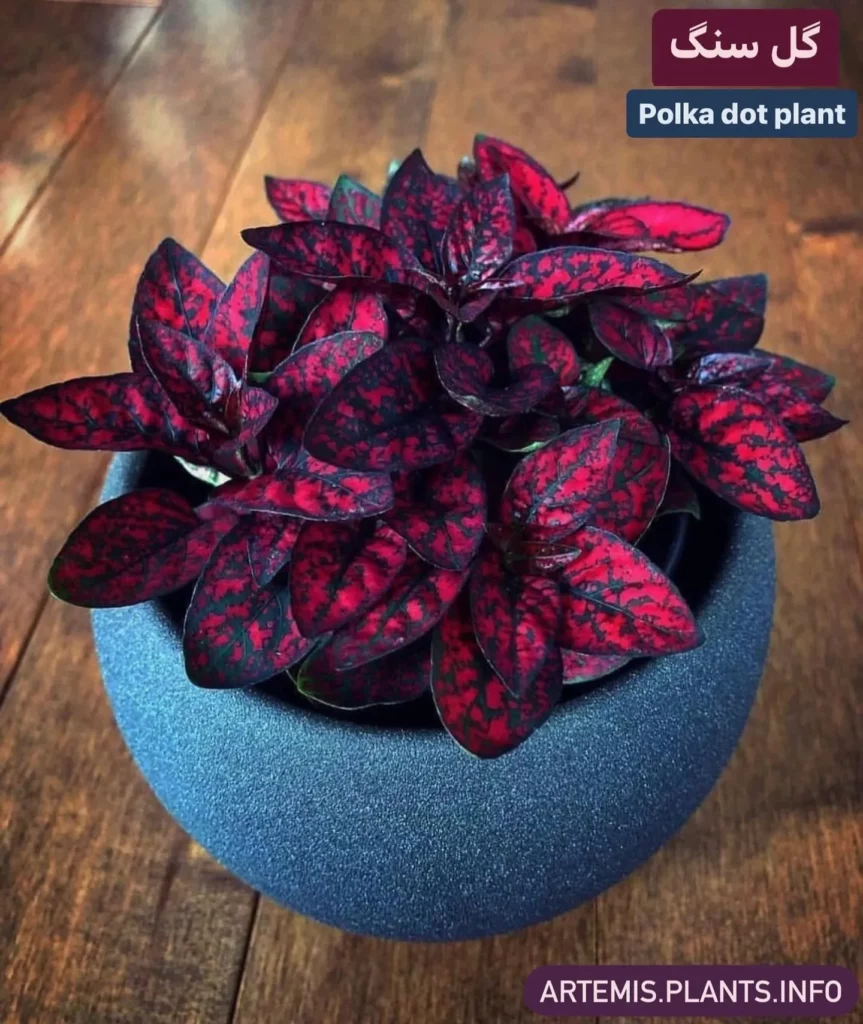
Polka Dot Plant, also known as Hypoestes phyllostachya, is prized for its striking and unique appearance. It features freckled leaf patterns that can be truly polka dotted or more freckled, splashed, or splotched. The leaves come in a variety of colors, ranging from classic white and green to bubblegum pink or watermelon red variegation. The compact and mounding growth habit of Polka Dot Plant makes it a visually appealing choice for gardens and indoor spaces. Its ornamental foliage adds a touch of charm and liveliness to any setting, making it a popular choice among plant enthusiasts.
Light Requirements for Polka Dot Plant

Polka Dot Plant thrives in part to full shade conditions, making it an ideal choice for indoor decor. While it prefers medium to bright light, it can also tolerate both full sun and shade. However, it’s important to note that exposing the plant to light that is either too low or too intense may cause the colorful leaves to fade or bleach.
When growing Polka Dot Plant indoors, it’s best to place it in a spot that receives medium-bright indirect light. This will allow the plant to thrive without being exposed to direct sunlight. If the space is very bright, consider displaying the plant away from the window or using sheer curtains to filter the light. By providing the appropriate light conditions, you can ensure that Polka Dot Plant retains its vibrant and colorful foliage, adding a beautiful touch to your indoor decor.
For a visual representation of the shade requirements for Polka Dot Plant, refer to the table below:
| Light Level | Conditions |
|---|---|
| Part Shade | Polka Dot Plant thrives in areas with filtered light or indirect sunlight. It can tolerate some direct sunlight, but exposure to intense afternoon sun should be avoided. |
| Full Shade | Polka Dot Plant can also grow well in areas with low light conditions. It can tolerate shady spots where other plants may struggle. |
Watering Polka Dot Plant

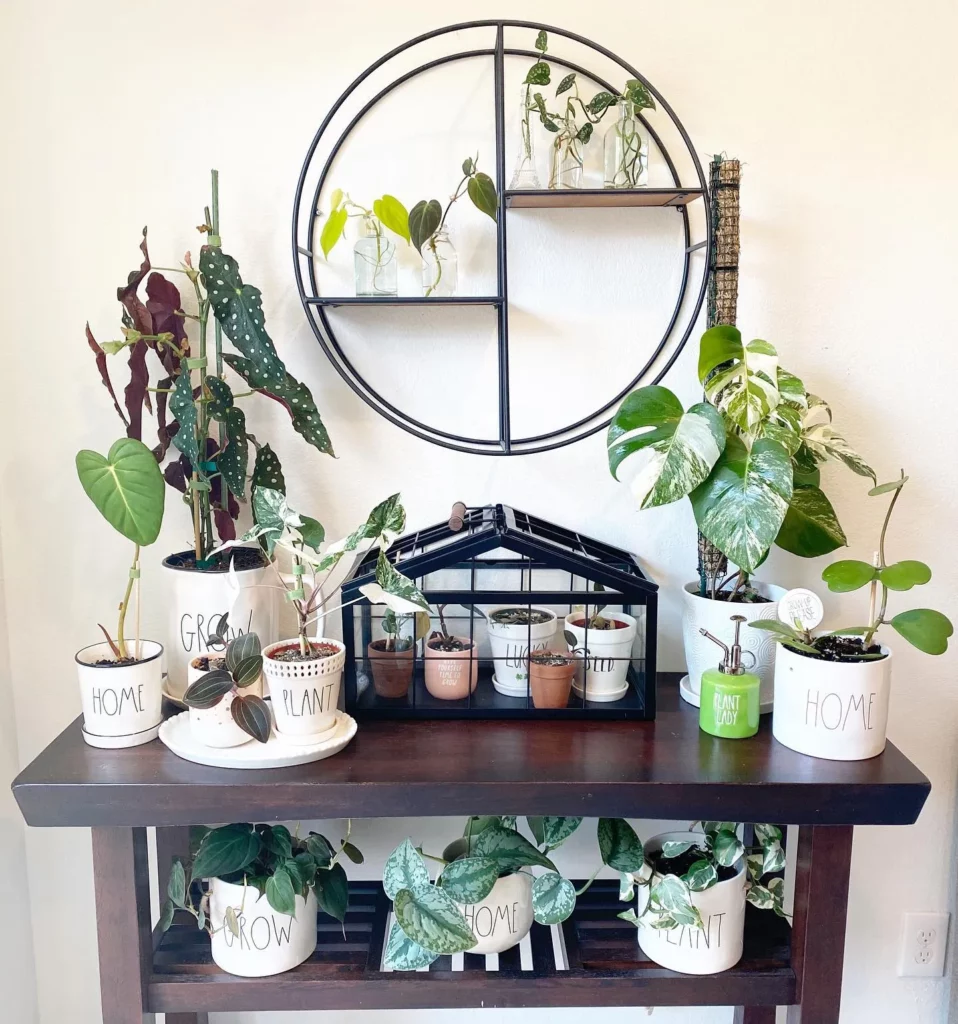

Proper watering is essential for maintaining the health and vitality of your Polka Dot Plant. While it prefers to be kept moist, it’s important not to overwater and allow the soil to become overly saturated. Your Polka Dot Plant is not drought tolerant, so regular watering is necessary to ensure its well-being.
To determine when to water, it’s crucial to monitor the soil moisture. A good practice is to use your finger to gauge the soil’s dryness. The soil should be slightly dry before watering again, as overly wet conditions can cause root rot and other issues.
If the natural rainfall or manual watering is not sufficient, you may consider setting up an irrigation system to provide a consistent water supply to your Polka Dot Plant. This can help ensure that it receives adequate hydration.
Fertilizing Polka Dot Plant

Polka Dot Plant benefits from regular fertilization to promote healthy and abundant growth. By providing the necessary nutrients, you can help your Polka Dot Plant maintain its lush foliage and continue to thrive. When it comes to fertilizing your Polka Dot Plant, there are a few key considerations to keep in mind.
An all-purpose organic fertilizer, whether in liquid or granular form, is a great choice for feeding your Polka Dot Plant. Look for a fertilizer that is specifically labeled as organic and follow the package instructions for application rates. Organic fertilizers promote overall plant health and help create a sustainable and eco-friendly gardening environment.
It’s important to fertilize your Polka Dot Plant during its active growing season, which typically occurs from April to September. This is when the plant is actively taking in nutrients and putting forth new growth. By providing additional fertilizer during this time, you can support vigorous and vibrant foliage.
If you are caring for your Polka Dot Plant indoors, it’s important to use an indoor-specific organic fertilizer. Indoor fertilizers are specially formulated to meet the needs of houseplants, providing the nutrients they require for optimal growth in an indoor environment. Look for a fertilizer that is labeled as suitable for indoor use.
Remember to always read and follow the instructions provided by the fertilizer manufacturer. Applying too much fertilizer can damage your Polka Dot Plant, so it’s best to err on the side of caution and apply fertilizer according to the recommended rates. With regular fertilization, your Polka Dot Plant will thrive and bring vibrant color to your indoor garden.
Potting Polka Dot Plant


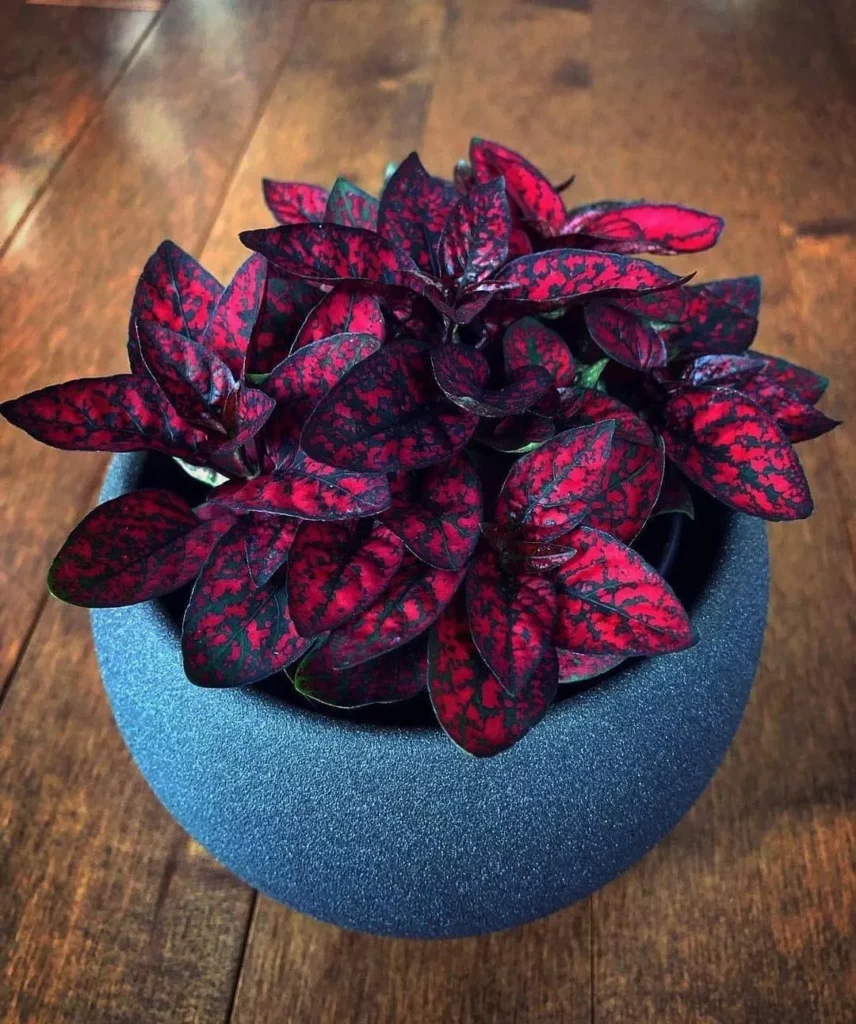
Proper potting is essential for the health and growth of your Polka Dot Plant. Follow these tips to ensure your plant thrives in its new home.
First, choose a well-draining soil to prevent waterlogging and root rot. This will help maintain the optimal moisture levels for your plant.
No products found.
Amend the soil with organic matter to improve its fertility and drainage. This can include compost or peat moss, which will provide essential nutrients and promote healthy root development.
Additionally, consider adding a slow-release organic fertilizer to the soil. This will provide a steady supply of nutrients over time, supporting the growth and vitality of your Polka Dot Plant.
When potting your plant, select a container that allows for future growth. Transplanting into a larger pot may be necessary as the plant continues to grow. A good rule of thumb is to repot every 12-18 months or when the water starts running straight through the pot during watering, indicating the plant is rootbound.
A properly potted Polka Dot Plant will have enough space to grow and thrive, ensuring a vibrant and lush addition to your indoor garden.
| Steps for Potting Polka Dot Plant |
|---|
| 1. Select a well-draining soil mix. |
| 2. Amend the soil with organic matter (such as compost or peat moss). |
| 3. Add a slow-release organic fertilizer. |
| 4. Choose a container that allows for future growth. |
| 5. Transplant into a larger pot if necessary. |
Propagating Polka Dot Plant

If you want to expand your collection of Polka Dot Plants or share this beautiful plant with others, propagation through stem cuttings is a straightforward and effective method. Here’s how to propagate your Polka Dot Plant:
- Start by taking a stem cutting that is approximately 4 inches in length.
- Strip off the leaves from the lower half of the stem.
- Moisten some well-draining potting soil, such as cactus soil.
- Insert the cutting into the soil, up to the first set of remaining leaves.
- Keep the soil moist for the next four weeks. This helps the roots to develop.
- Once the roots are established, you can pot up the rooted cuttings in their own small containers for continued growth.
- If you want to encourage faster root development, you can dip the edge of the stems in a growth hormone before potting.
Growth and Development of Polka Dot Plant
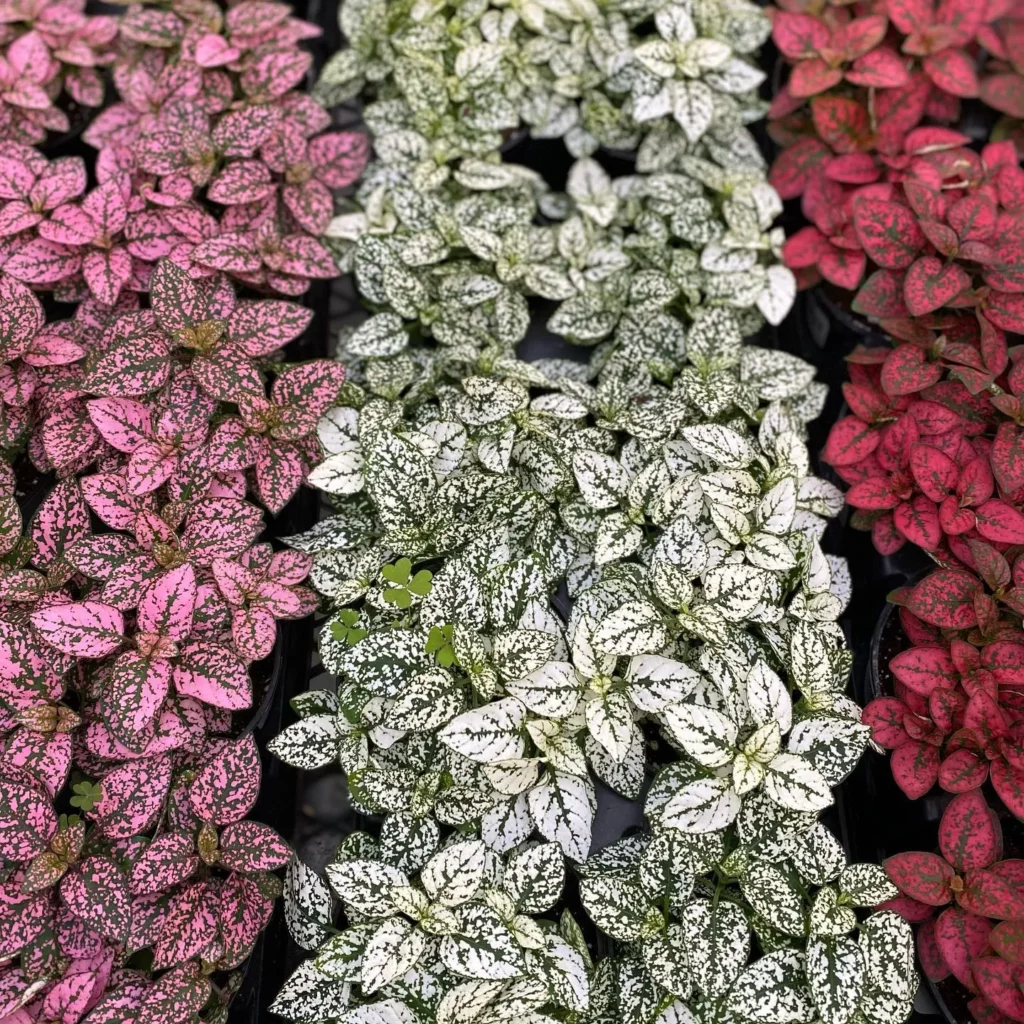


With proper care, your Polka Dot Plant will grow and develop into a full and vibrant plant. This compact and mounding plant can reach a height of 16-22 inches and a width of 18-24 inches, creating a beautiful display of lush foliage in your garden or indoor space.
To achieve full coverage of color, it is recommended to space your Polka Dot Plants 10-12 inches apart. This ensures that each plant has enough room to grow and showcase its vibrant freckled leaf patterns.
As the growing season progresses, your Polka Dot Plant will become increasingly full and lush. With its striking appearance, it adds a touch of charm and liveliness to any setting.
In late summer and early fall, your Polka Dot Plant may surprise you with small, tubular purple flowers. While the flowers themselves may not be showy, they beautifully complement the bold foliage of the plant, adding another dimension to its overall appeal.
To encourage low and lush foliar growth and branching, you can pinch and prune your Polka Dot Plant. This helps create a sturdier and fuller plant, enhancing its visual impact.
Polka Dot Plant Growth Tips:
- Space Polka Dot Plant 10-12 inches apart for full coverage color
- Pinch and prune to encourage low and lush foliar growth
- Enjoy the small, tubular purple flowers in late summer and early fall
- Admire the compact and mounding growth habit, reaching a height of 16-22 inches and a width of 18-24 inches
| Aspect of Growth | Description |
|---|---|
| Growth Habit | Compact and mounding |
| Height | 16-22 inches |
| Width | 18-24 inches |
| Flowering | Small, tubular purple flowers in late summer and early fall |
| Pruning | Encourages low and lush foliar growth |
Pests and Diseases of Polka Dot Plant

While the Polka Dot Plant is generally resilient, it is still important to be aware of potential pests and diseases that can affect its health. By taking proper precautions and implementing preventative measures, you can ensure your Polka Dot Plant remains vibrant and thriving.
Powdery Mildew
One common issue that may arise is powdery mildew, a fungal disease that appears as a white powdery coating on the leaves. This can occur when there is high humidity and poor air circulation. To prevent powdery mildew, make sure to provide adequate ventilation and avoid overwatering. If you notice signs of powdery mildew, treat the plant with a fungicide specifically formulated for powdery mildew.
Root Rot
Root rot is another potential problem that can affect the Polka Dot Plant, especially if the soil is consistently overwatered or lacks proper drainage. To prevent root rot, make sure to water the plant properly, allowing the soil to dry out slightly between waterings. If root rot has already developed, you may need to repot the plant into fresh, well-draining soil.
Pest Infestations
No products found.
Polka Dot Plants can also potentially attract pest infestations, including aphids, white flies, and mealybugs. These pests can cause damage to the foliage and negatively impact the plant’s overall health. To address pest infestations, you can manually remove the insects or use organic pest control products like Safer Soap or neem oil. It’s important to closely monitor your plant and take prompt action at the first sign of pests.
In severe cases where pests or diseases have caused significant damage to the plant, it may be necessary to remove and discard the affected foliage to prevent further spread. This will help protect the health of the remaining plant and provide an opportunity for new growth.
| Pest/Disease | Symptoms | Prevention | Treatment |
|---|---|---|---|
| Powdery Mildew | White powdery coating on leaves | Improve air circulation and reduce humidity | Treat with a fungicide for powdery mildew |
| Root Rot | Wilting, yellowing leaves; foul odor from soil | Provide well-draining soil and avoid overwatering | Repot into fresh soil and improve drainage |
| Aphids | Tiny insects on leaves; sticky residue | Regularly inspect and remove any visible pests | Use organic pest control products or insecticidal soap |
| White Flies | Tiny, white flying insects on leaves | Monitor plant closely and take prompt action | Use organic pest control products or insecticidal soap |
| Mealybugs | Fuzzy, white insects on leaves and stems | Inspect new plants before introducing them to your collection | Use organic pest control products or insecticidal soap |
Keeping Polka Dot Plant Indoors

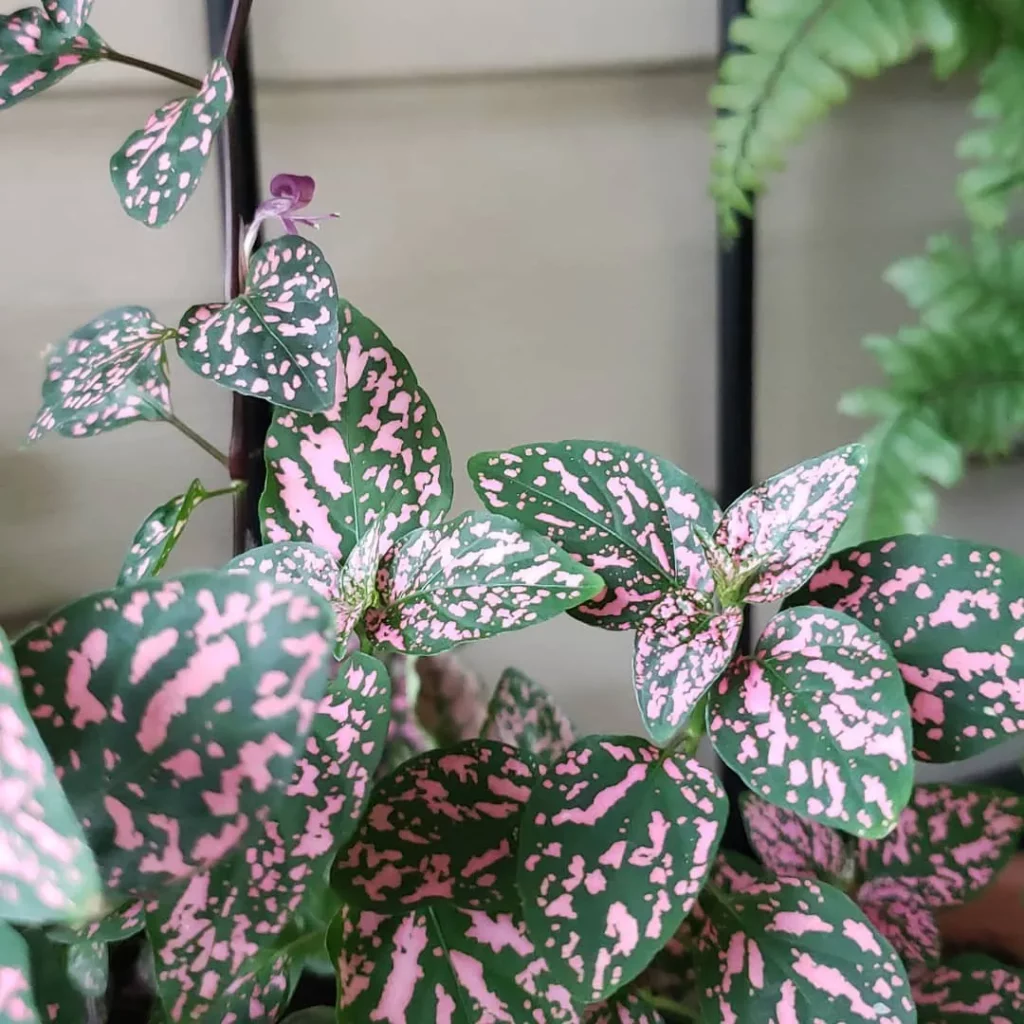
Polka Dot Plant is an ideal choice for indoor gardening enthusiasts due to its stunning foliage and low-maintenance care requirements. This beautiful plant can thrive year-round indoors, bringing effortless style to any space. Plus, it’s pet-friendly, making it a great option for households with furry friends.
When keeping Polka Dot Plant indoors, it’s crucial to find the right spot for it. Place the plant in an area that receives medium-bright indirect light. However, if the space is overly bright, it’s best to keep the plant away from direct sunlight to prevent any potential damage to its foliage.
Maintaining a regular watering routine is essential for the health of your Polka Dot Plant. Allow the top layer of the soil to slightly dry between waterings, as the plant prefers to be kept moist but not overly saturated. To help create the ideal growing environment, you can set the pots on a tray filled with moistened pebbles. This will provide the steady humidity that tropical plants like Polka Dot Plant thrive in.
Overall, Polka Dot Plant is a versatile and visually captivating addition to any indoor space. With its medium-bright indirect light requirements, easy watering routine, and pet-friendly nature, this plant is sure to bring beauty, color, and a touch of nature’s elegance to your home.
FAQ
What are some tips for caring for a Polka Dot Plant?
To care for a Polka Dot Plant, make sure to provide it with part to full shade, water it regularly without over-saturating the soil, fertilize it with organic fertilizer during the active growing season, and use well-draining soil when potting it.
What is the appearance of a Polka Dot Plant?
A Polka Dot Plant has freckled leaf patterns, which can vary from polka dots to splashes and splotches. The leaves come in a variety of colors, including white and green, bubblegum pink, and watermelon red variegation.
What are the light requirements for a Polka Dot Plant?
Polka Dot Plants thrive in part to full shade conditions. While they can tolerate medium to bright light, it’s best to place them in a spot that receives medium-bright indirect light indoors to prevent foliage damage.
How should I water a Polka Dot Plant?
Polka Dot Plants prefer to be kept moist but not overly saturated. Make sure to monitor the soil moisture and water the plant when the soil is slightly dry. It’s important to prevent drought by regularly watering the plant.
How should I fertilize a Polka Dot Plant?
You can fertilize a Polka Dot Plant with an all-purpose organic fertilizer according to the package instructions. It’s recommended to fertilize the plant during the active growing season and use an indoor-specific organic fertilizer if caring for it indoors.
How should I pot a Polka Dot Plant?
When potting a Polka Dot Plant, use well-draining soil amended with organic matter. Adding slow-release organic fertilizer to the soil can provide necessary nutrients. Repot the plant every 12-18 months or when it becomes rootbound.
How can I propagate a Polka Dot Plant?
Polka Dot Plants can be easily propagated through stem cuttings. Take a 4-inch stem cutting and insert it into moistened potting soil. Keep the soil moist until roots develop, then pot up the rooted cuttings in their own containers for continued growth.
How does a Polka Dot Plant grow and develop?
A Polka Dot Plant has a compact and mounding growth habit, reaching a height of 16-22 inches and a width of 18-24 inches. It can be spaced 10-12 inches apart for full coverage color. Pinching and pruning the plant encourages low and lush foliar growth.
What pests and diseases should I watch out for with a Polka Dot Plant?
While Polka Dot Plants are not particularly susceptible to pests or diseases, common issues to watch out for include powdery mildew, root rot, aphids, white flies, and mealybugs. Regular care and maintenance can help prevent these problems.
Can I keep a Polka Dot Plant indoors?
Yes, Polka Dot Plants are excellent for indoor gardening. Place them in a spot that receives medium-bright indirect light, maintain a regular watering routine, and provide steady humidity through methods like setting pots on a tray of moistened pebbles.





